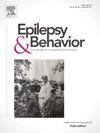刚地弓形虫血清阳性作为癫痫的危险因素:一项不一致的同卵双胞胎研究
IF 2.3
3区 医学
Q2 BEHAVIORAL SCIENCES
引用次数: 0
摘要
目的据报道,刚地弓形虫(弓形虫)血清阳性可使癫痫风险增加5倍。然而,这些研究在方法论上存在很大的异质性。此外,其他研究未能复制弓形虫血清阳性与癫痫之间的关联。为了解决这些不一致,我们在癫痫不一致的同卵(MZ)双胞胎中研究了这一问题,这种方法控制了年龄、性别和遗传因素。方法对32对癫痫不一致的MZ双胞胎进行分析,比较患病双胞胎和未患病双胞胎的弓形虫血清IgG阳性率。使用McNemar的卡方配对比例检验计算患病双胞胎与未患病双胞胎的弓形虫血清阳性的比值比。使用Fisher精确检验和Welch t检验评估与弓形虫血清阳性相关的因素。结果患病双胞胎的血清阳性频率与未患病双胞胎的血清阳性频率无差异(优势比为1.67 [95% CI: 0.39-6.97], p = 0.72),表明该队列中弓形虫血清阳性与癫痫无显著相关性。检测年龄与弓形虫血清阳性相关,血清阳性个体比血清阴性个体年龄大[平均检测年龄(SD) 59.1岁(12.6)vs 47.7岁(14.3),p = 0.03]。结论在癫痫不一致的MZ双胞胎队列中,我们没有发现弓形虫血清阳性与癫痫之间存在关联的证据。更大规模的仔细对照研究是有必要的。本文章由计算机程序翻译,如有差异,请以英文原文为准。
Toxoplasma gondii seropositivity as a risk factor for epilepsy: A discordant monozygotic twin study
Objective
Toxoplasma gondii (T. gondii) seropositivity has been reported to have up to a five-fold increased risk for epilepsy. However, substantial heterogeneity in methodology exists across these studies. Furthermore, other studies failed to replicate an association between T. gondii seropositivity and epilepsy. To address these inconsistencies, we investigated this issue in monozygotic (MZ) twin pairs discordant for epilepsy, a method that controls for age, sex and genetic factors.
Methods
We analyzed 32 MZ twin pairs who are discordant for epilepsy, comparing rates of T. gondii seropositivity (IgG) between affected and unaffected twins. The odds ratio for T. gondii seropositivity in affected twins compared to their unaffected co-twins was calculated using McNemar’s chi-squared paired proportion test. Factors associated with T. gondii seropositivity were assessed using Fisher’s exact test and Welch’s t-test, as appropriate.
Results
The frequency of seropositivity in affected twins compared to their unaffected co-twins did not differ (odds ratio of 1.67 [95 % CI: 0.39–6.97], p = 0.72), indicating no significant association between T. gondii seropositivity and epilepsy in this cohort. Age at testing was associated with T. gondii seropositivity, with individuals found to be seropositive being older than those who were seronegative [mean age at testing (SD) 59.1 years (12.6) vs 47.7 years (14.3), p = 0.03].
Conclusion
In our cohort of MZ twins discordant for epilepsy, we found no evidence for an association between T. gondii seropositivity and epilepsy. Larger carefully controlled studies are warranted.
求助全文
通过发布文献求助,成功后即可免费获取论文全文。
去求助
来源期刊

Epilepsy & Behavior
医学-行为科学
CiteScore
5.40
自引率
15.40%
发文量
385
审稿时长
43 days
期刊介绍:
Epilepsy & Behavior is the fastest-growing international journal uniquely devoted to the rapid dissemination of the most current information available on the behavioral aspects of seizures and epilepsy.
Epilepsy & Behavior presents original peer-reviewed articles based on laboratory and clinical research. Topics are drawn from a variety of fields, including clinical neurology, neurosurgery, neuropsychiatry, neuropsychology, neurophysiology, neuropharmacology, and neuroimaging.
From September 2012 Epilepsy & Behavior stopped accepting Case Reports for publication in the journal. From this date authors who submit to Epilepsy & Behavior will be offered a transfer or asked to resubmit their Case Reports to its new sister journal, Epilepsy & Behavior Case Reports.
 求助内容:
求助内容: 应助结果提醒方式:
应助结果提醒方式:


